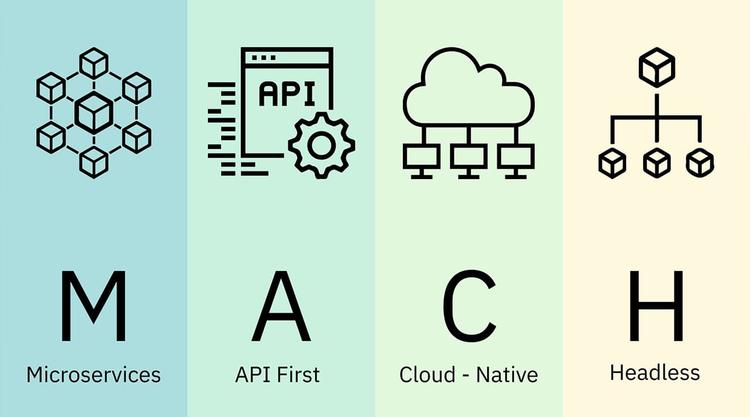How Can MACH Architecture Boost Digital Transformation?
Sector: Digital Commerce
Author: Nisarg Mehta
Date Published: 03/14/2023

Contents
- Introduction to MACH Architecture
- The Benefits of MACH Architecture
- How MACH Architecture Can Support Digital Transformation
- Exploring MACH Architecture Best Practices
- MACH Architecture Use Cases
- Challenges with MACH Architecture
- Tips for Designing and Implementing MACH Architecture
- How to Measure the Success of Your MACH Architecture
- Conclusion
The world of technology is constantly evolving, and organizations of all sizes are looking for ways to stay competitive and drive innovation.
Customer demands are changing, and so do the touchpoints. Being available at every touchpoint requires technology officers to invest in several technologies, which increases the complexity and cost of the organization’s technology infrastructure.
To curb this, one of the most popular approaches modern technology experts use is the MACH architecture.
MACH stands for Microservices, APIs, Cloud, and Headless, and it is an architecture that enables companies to quickly develop, deploy, and scale applications.
In this article, we will explore what MACH architecture is, the benefits of using it, how it can support digital transformation, and tips for designing and implementing MACH architecture.
Introduction to MACH Architecture
MACH architecture is a modern approach to application development that enables organizations to build agile, scalable, and highly available applications. It is based on microservices, APIs, cloud, and headless architecture principles. Hence called MACH.
Here, microservices are small, independent services that are loosely coupled and can be developed, deployed, and scaled independently. They allow organizations to quickly develop, deploy, and scale applications with minimal effort.
APIs are used to enable applications to communicate with each other and access data from various sources.
Cloud computing provides organizations with on-demand computing resources and allows them to scale applications quickly and easily.
Headless architecture is a web-based architecture where the front-end and back-end of an application are decoupled. This allows organizations to quickly deploy and manage applications without having to worry about the underlying infrastructure.
MACH architecture allows organizations to quickly build, deploy, and scale applications without worrying about the underlying infrastructure. This makes it the perfect choice for organizations that are looking to drive digital transformation.
Let’s know more advantages.
The Benefits of MACH Architecture
The benefits include:
Agility
MACH architecture enables organizations to quickly develop, deploy, and scale applications with minimal effort. This makes it perfect for organizations that need to move quickly to stay competitive.
Scalability
resources, allow them to quickly and easily scale applications. This makes it easier for organizations to respond to changes in the market and customer demands.
Cost Efficiency
MACH architecture enables organizations to quickly develop and deploy applications without having to invest in additional hardware or software. This helps organizations save on costs and allows them to focus their resources on more strategic initiatives.
Flexibility
MACH architecture enables organizations to quickly develop, deploy, and scale applications without having to worry about the underlying infrastructure. This makes it easier for organizations to adapt to changes in the market and customer demands.
Innovation
MACH architecture enables organizations to quickly develop and deploy applications without having to worry about the underlying infrastructure. This allows organizations to focus their resources on developing new features and products to stay competitive.
How MACH Architecture Can Support Digital Transformation
MACH architecture can support digital transformation by enabling organizations to quickly develop and deploy applications that are agile, scalable, and cost-effective. This allows organizations to respond quickly to market and customer demand changes.
MACH architecture also enables organizations to quickly develop, deploy, and scale applications without worrying about the underlying infrastructure. This makes it easier for organizations to innovate and develop new features and products to stay competitive.
Exploring MACH Architecture Best Practices
There are a number of best approaches that organizations should follow when designing and implementing MACH architecture. These include:
Design for Scalability
Organizations should design their applications for scalability, so they can quickly respond to changes in the market and customer demands. This can be done by leveraging cloud computing to provide on-demand computing resources and utilizing API gateways to manage application traffic.
Leverage microservices
Organizations should leverage microservices to develop, deploy, and scale applications fast. As stated before, this allows them to respond quickly to changes in the market and customer demands.
Create a Secure Infrastructure
Organizations should create a secure infrastructure to ensure that applications are secure and protected from potential threats. This can be done by leveraging encryption technologies, authentication protocols, and access control measures.
Monitor and Optimize Performance
Organizations should monitor and optimize the performance of their applications to ensure they are running efficiently. This can be done by leveraging monitoring tools and performance metrics.
Following these best practices will help organizations ensure that their MACH architecture applications are secure, scalable, and performant.
MACH Architecture Use Cases
MACH architecture can be used for a variety of use cases, including:
IoT
MACH architecture is a new way to decentralize the Internet of Things (IoT). It enables secure, distributed, resilient, and trustless communication between devices and applications.
The MACH architecture allows for automated transactions among multiple participants, enabling applications like decentralized finance (DeFi). With MACH, all data is stored in an immutable, open ledger that all participants in the network can verify. This ensures that data remains private and secure.
The MACH architecture has numerous benefits for IoT networks, including increased scalability, improved privacy and security, cost savings on hardware and energy consumption, faster development cycles, and reduced latency due to its decentralized nature.
With these advantages and more, MACH hopes to empower developers to create innovative applications that will revolutionize IoT networks and help lead us into a connected future.
Data Analysis
MACH Architecture makes data analysis and decision-making easier for organizations by utilizing distributed ledger technology to securely store and analyze large amounts of data. This allows for faster processing of data and the ability to make decisions in real-time. By using this architecture, organizations can quickly access and analyze large volumes of data without having to build complex systems or manage infrastructure. This reduces development time and cost while allowing organizations to make better-informed decisions quickly.
Additionally, with the immutable nature of distributed ledgers, organizations can trust that their data is secure, private, and reliable. Hence, with MACH Architecture, organizations can benefit from a robust system that allows them to leverage their data for improved decision-making.
Mobile
The MACH Architecture is designed to simplify and accelerate the mobile development process. It eliminates the need to build separate mobile applications for each platform, allowing developers to focus on creating a single, cross-platform application. By leveraging cloud computing and other technologies, developers can create a unified mobile experience that can be deployed quickly across multiple platforms.
Additionally, MACH enables developers to have more control over their data and application lifecycles while simplifying user authentication and providing secure connections between devices.
Ultimately, MACH makes it easier for organizations to develop powerful mobile applications quickly in order to meet their business objectives.
Automation
MACH Architecture can be used to develop applications that enable organizations to automate complex business processes quickly. This architecture simplifies the development process by leveraging distributed ledger technology to store and analyze data. This allows for faster processing of data and the ability to make decisions in real-time.
Additionally, applications built using MACH architecture can leverage blockchain technology for secure data storage and cryptographic authentication for secure transactions. By utilizing these technologies, organizations can easily build automated processes that are secure, reliable, and efficient. This can reduce development costs and improve decision-making, as organizations are able to access large amounts of data quickly and accurately.
Furthermore, integrating MACH architecture with other technologies, such as artificial intelligence (AI), can further improve the efficiency of automation processes, allowing companies to gain a competitive edge in their respective industries.
Challenges with MACH Architecture
While MACH architecture provides organizations with several benefits, organizations should be aware of a number of challenges. These include:
- Security: MACH architecture can present security challenges if organizations do not have the necessary security measures in place. This can include authentication protocols, encryption technologies, and access control measures.
- Complexity: MACH architecture can be complex to design and implement, especially for organizations that are new to developing applications. This can lead to longer development times and higher costs.
- Integration: MACH architecture can be difficult to integrate with existing systems, leading to longer development times and higher costs.
- Testing: MACH architecture can be difficult to test and can require organizations to invest in additional testing tools and processes.
Tips for Designing and Implementing MACH Architecture
MACH architecture can be a powerful tool for driving digital transformation, but organizations should take the time to design and implement their applications properly. Here are some tips for designing and implementing MACH architecture:
Start Small
Organizations should start small and focus on developing a single application at a time. This will help organizations get familiar with MACH architecture and develop applications that are secure, reliable, and performant.
Focus on Scalability
Organizations should design their applications for scalability, so they can quickly respond to changes in the market and customer demands. This can be done by leveraging cloud computing to provide on-demand computing resources and utilizing API gateways to manage application traffic.
Test Thoroughly
Organizations should thoroughly test their applications to ensure they are secure, reliable, and performant. They should leverage automated testing tools and simulate real-world scenarios to make it all happen.
Monitor Performance
Organizations should monitor the performance of their applications to ensure they are running efficiently. This can be done by leveraging monitoring tools and performance metrics.
By following these tips, organizations can ensure that their MACH architecture applications are secure, reliable, and performant.
How to Measure the Success of Your MACH Architecture
Organizations should measure the success of their MACH architecture applications to ensure that they are meeting their goals. Here are some metrics that organizations can use to measure the success of their MACH architecture applications:
- Time to Market: Organizations should measure the time it takes for them to develop and deploy applications. This will help them determine if they are meeting their development goals.
- Uptime: Organizations should measure the uptime of their applications to ensure they are meeting their availability goals.
- Response Times: Organizations should measure the response times of their applications to ensure they are meeting their performance goals.
- Customer Satisfaction: Organizations should measure customer satisfaction to ensure they are meeting their customer experience goals.
By measuring the success of their MACH architecture applications, organizations can ensure that they are meeting their goals and staying competitive.
Conclusion
MACH architecture is a powerful approach to application development that enables organizations to develop, deploy, and scale applications without having to worry about the underlying infrastructure. This makes it the perfect choice for organizations that are looking to drive digital transformation.
By following the best practices discussed in the article, organizations can ensure that their MACH architecture applications are secure, reliable, and performant.
Latest Tech Insights!
Join our newsletter for the latest updates, tips, and trends.



